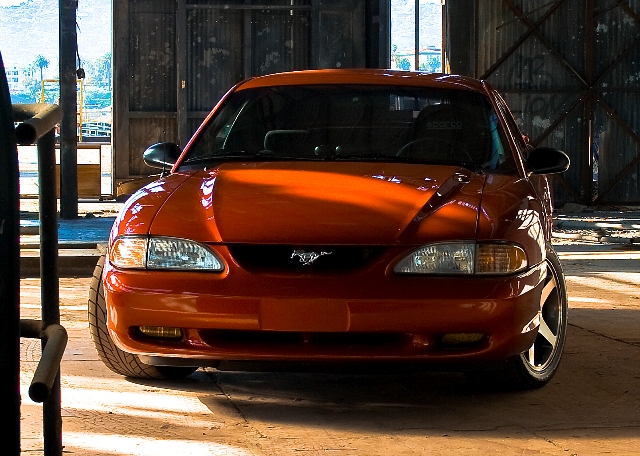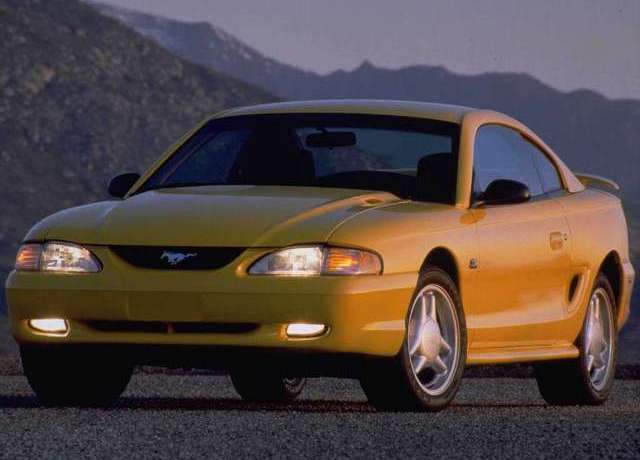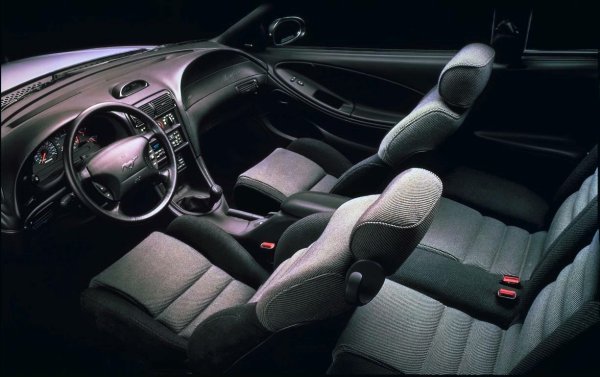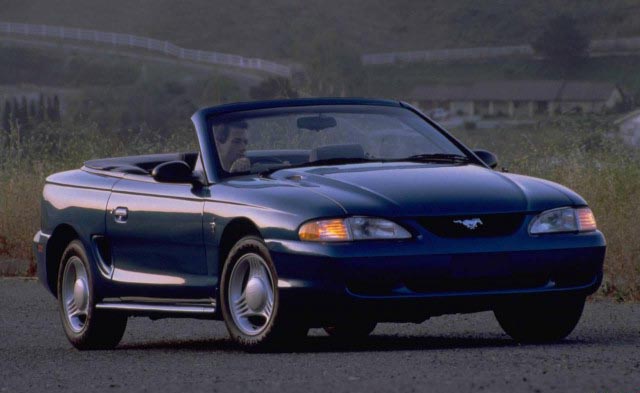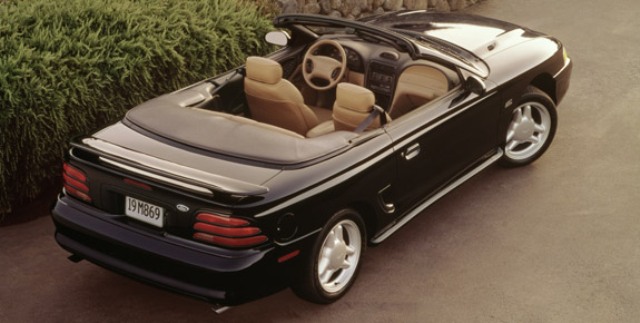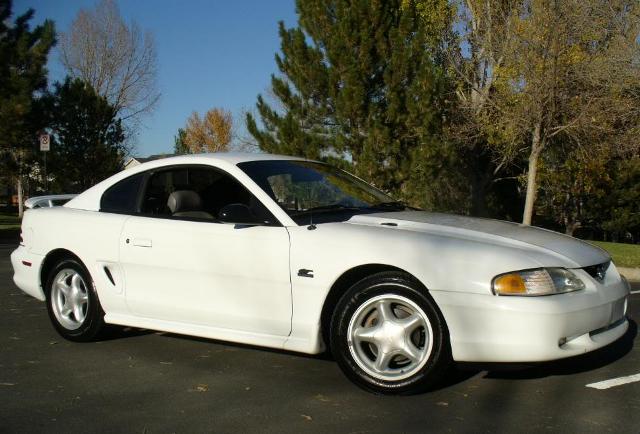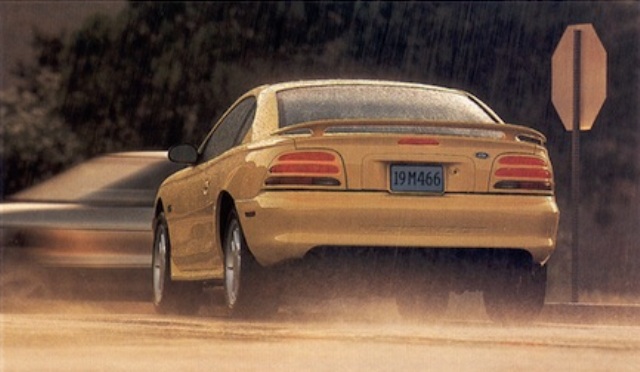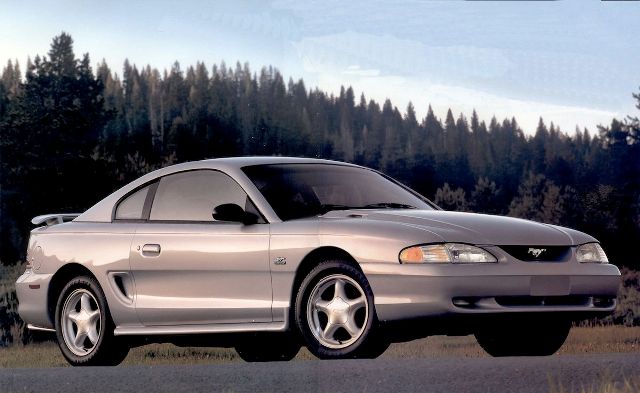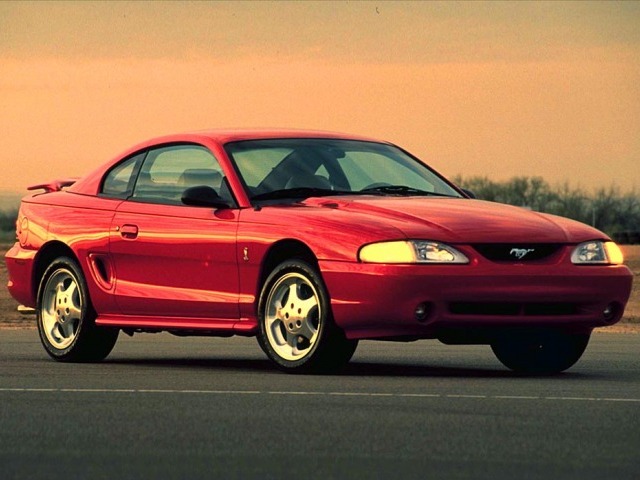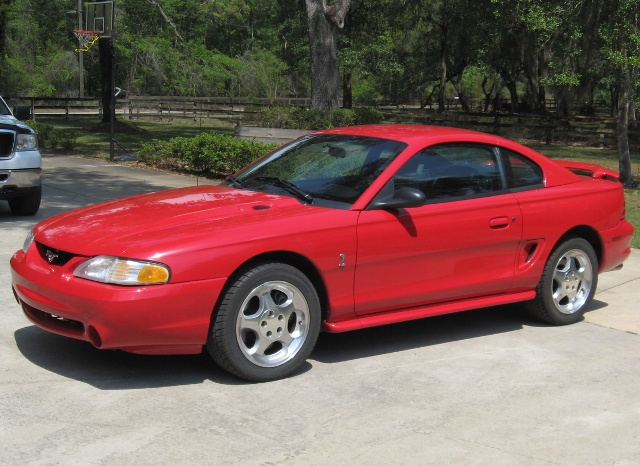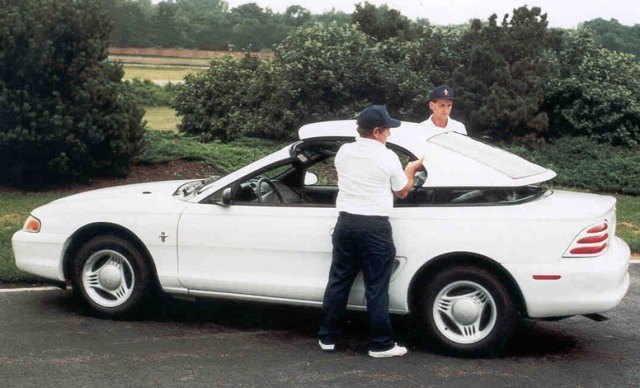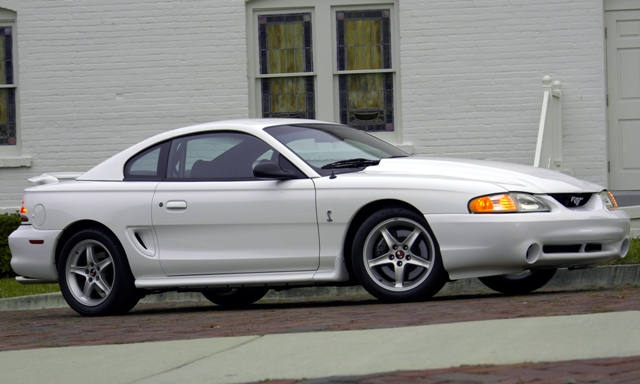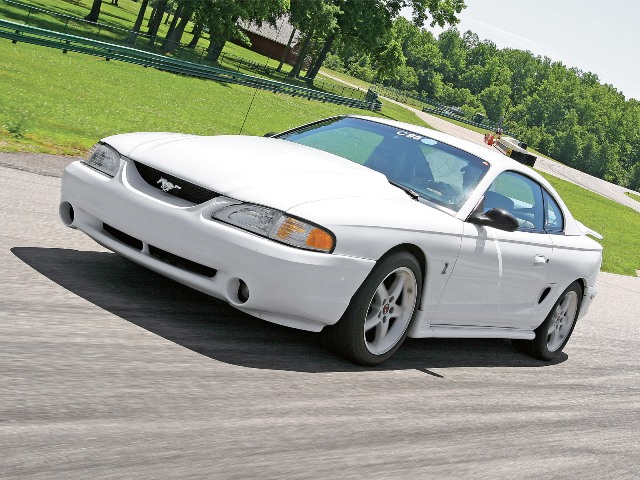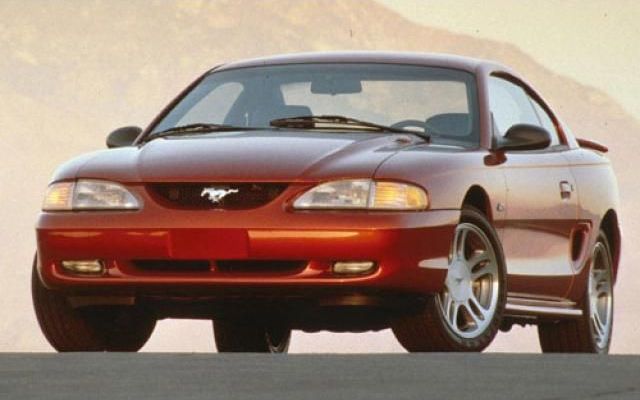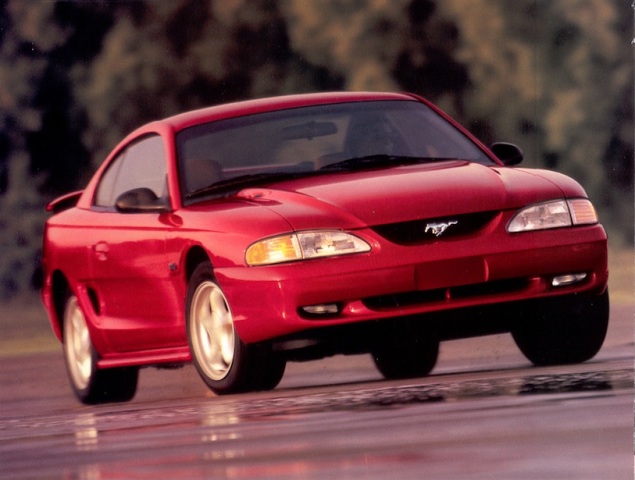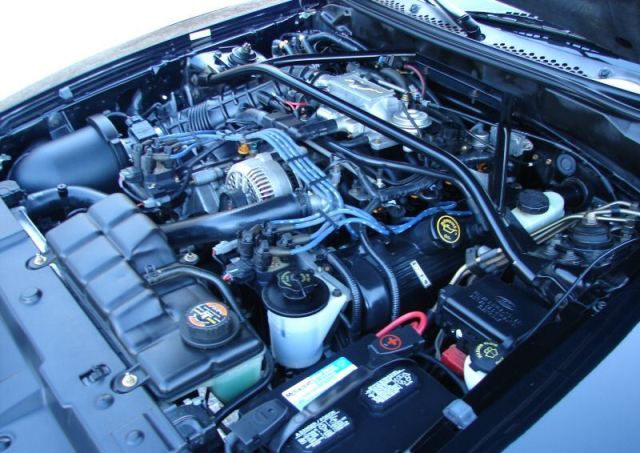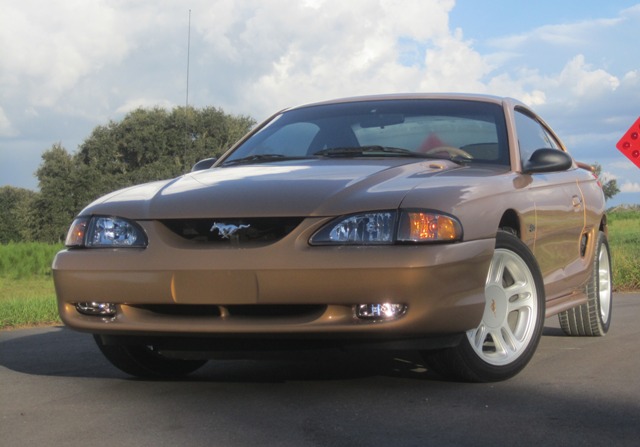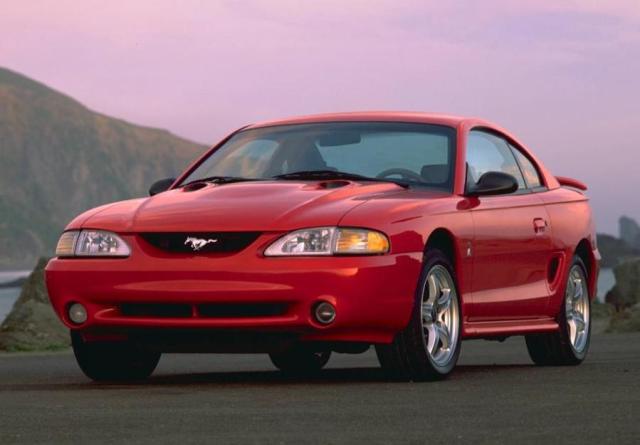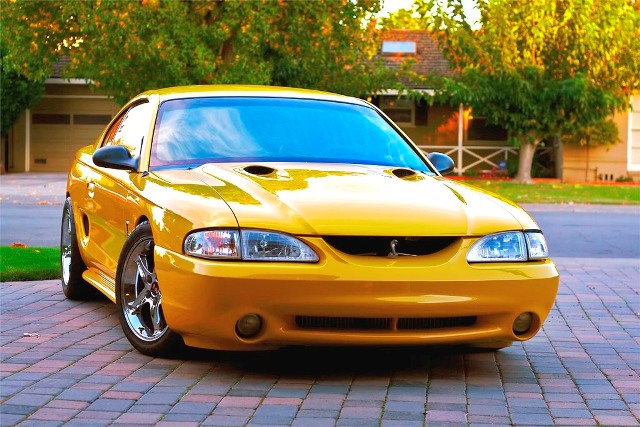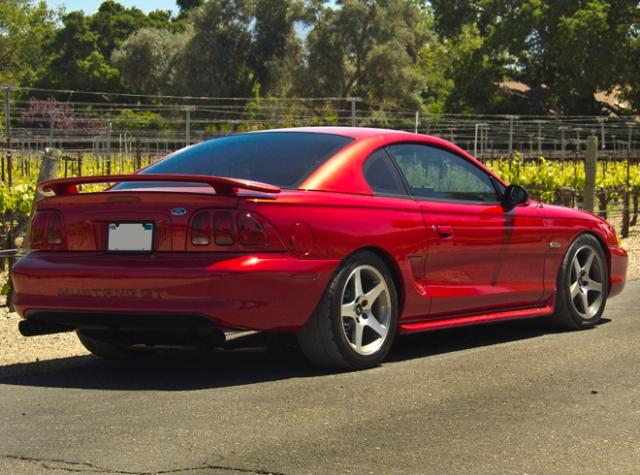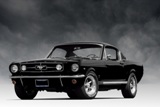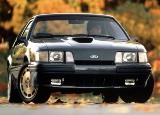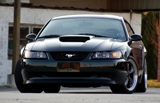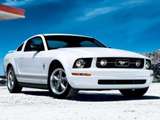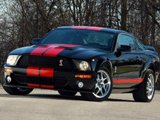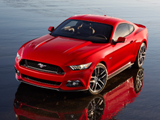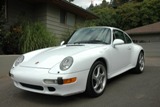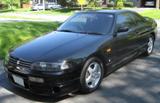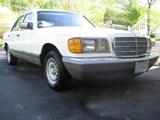Enthusiast's Corner
1994-1998 Ford Mustang: Something old, something new
Written by James Dolan
In the early 1990’s Pony car fans were clamoring for an all new Mustang to arrive. Although the Fox body Mustang was much loved, after 14 years in production its age was showing and had to be forced into retirement. It’s not as though Ford didn’t try to redesign the Mustang sooner. What eventually became the Ford Probe was originally supposed to be the all new Mustang for 1989. But after a customer revolt in 1987, rejecting the idea of a front wheel drive Mustang, Ford wisely listened and the concept of a V-8 powered rear wheel drive pony car wearing a Mustang badge lived.
Ford had to go back to the drawing board and start over, but they didn’t do so immediately. Executives still believed that America’s appetite for V-8 powered coupe would wane and sales of the Mustang would disappear. Besides industry rumors were swirling around that General Motors was working on a front wheel drive Camaro and Firebird for its next generation. Ford Motor Company decided to take a wait and see approach with the future of the Mustang.
However things changed in 1989. Sales of the Mustang were still strong and General Motors dropped the idea of converting the Camaro and Firebird to a front wheel drive platform and were diligently working on a new rear wheel drive car to be introduced in 1993. The top brass at Ford knew they had to counter G.M. with their own new pony car. In early 1989 a group named Team Mustang headed by John Coletti was assembled. The team was moved away from any corporate influences at Ford World Headquarters to an old warehouse south of Dearborn and given a modest budget of $700-million and a tight dead line of just 36 months to roll out a new Mustang. Work began in earnest on what was known internally as the SN-95 project (Sporty North American car project No.95).
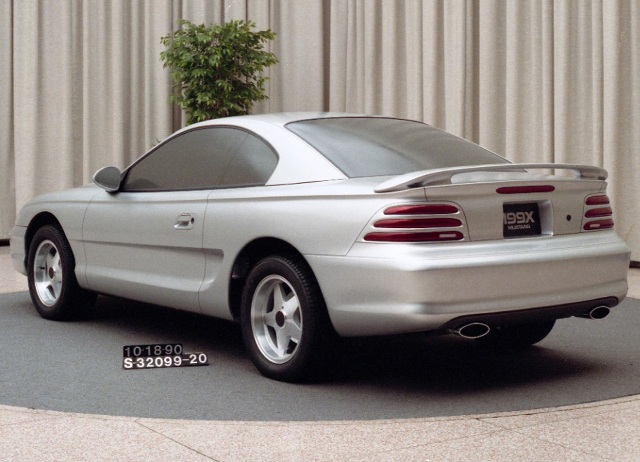
1994 Ford Mustang Concept - A clay model of what was to become the 1994 Mustang in the fall of 1990.
Finally a new Mustang was released in late 1993 for the ’94 model year. Inside and out the car looked all new with some touches that harkened back to Mustang of the past such as tri-bar taillights, quarter panel side coupes and a running horse in the grille. The changes inside were just as dramatic with an all new interior with a dash that was thoroughly modern in function yet retro in appearance. While everything looked all new the 1994 Mustang felt rather familiar when one climbed inside and sat behind the wheel. The sense of familiarity continued if you scratched just below the surface and looked under the hood and beneath the car. Once again the Fox platform lived to see another day, although in a highly revised and reengineered form that promised to usher the Mustang into the next millennium.
Early on auto journalists and enthusiasts presumed that the new Mustang would be based in a cut down version of Ford’s sensational new MN12 platform with four wheel independent suspension that had been the basis for the award winning ’89 Thunderbird. Rumors also persisted that a high output version of Ford’s new modular overhead cam V-8 would be installed under the hood.
However these technologies would prove to be prohibitively expensive for use in the Mustang. The MN12 platform had been hugely expensive for Ford to develop and cost over runs and production cost were so high that using this architecture for the Mustang was just not within the budget. Installing the modular V-8 was also deemed cost prohibitive for the time being at least as Ford had yet to develop a performance orientated version of that engine, so once again the 5.0-litre H.O. would be called up for use in the Mustang. In the end it was determined that the most cost effective option for a reasonably priced Mustang was to improve on the Mustang’s current underpinnings.
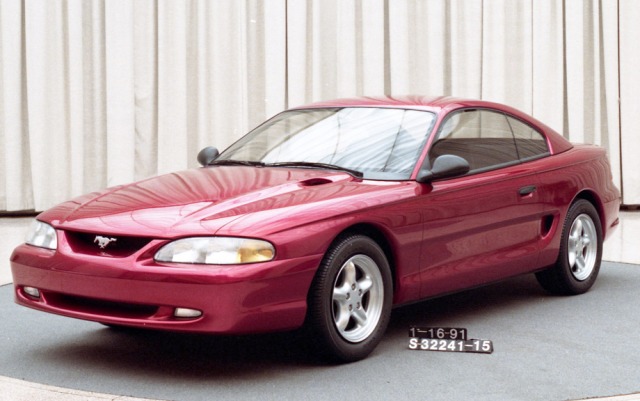
1994 Ford Mustang Concept - A fiberglass mock-up of the 1994 Mustang coupe in early 1991.
Although it may have come as a surprise to some and a disappointment to others that the SN95 Mustang was still based on the “old” Fox platform engineers worked long and hard to modernize and improve to Fox chassis for the new Mustang. As a matter of fact so many new or revised parts were used to the revised Fox platform that Ford renamed it “Fox-4”, a reference to the target launch date of 1994. Out of 1850 total parts, 1330 were redesigned or heavily modified for use in the revamped chassis. These changes were immensely successful, improving the Mustangs structural strength significantly. Compared to the 1993 Fox body Mustang the Fox-4 SN95 Mustang coupe reduced body flex by 56-percent and torsion rigidity was improved by 44-percent. Improvements for the convertible were even more dramatic.
From the on-set the SN95 Mustang convertible was developed separately from the coupe. This is in contrast to the 1983-1993 convertibles that were basically coupes with their roofs hacked off with some strategic bracing put in place. This separate development allowed engineers to properly strengthen the Fox-4 platform for use as a convertible. The convertible used thicker -gauge metal in key structural areas such as the rocker panels. An X-brace was used up front to reduce any twisting of the body structure and a 25-pound mass damper was fitted to the inside the right fender to counteract any unwanted vibrations that could possibly find their way into the passenger compartment. As a result the SN95 convertible was 76-percent stiffer in bending and torsion rigidity was improved by a remarkable 150-percent.
It might be easy to say that the 1994 Mustang was just a quick restyle; engineers went to great lengths to improve the car in everyway. To prove their point that the Fox-4 wasn’t just a carryover platform, Ford built full-sized chassis cutaways with the old carryover parts painted in white while the new components were painted in contrasting colours. When completed there wasn’t a whole lot of white parts on those models! Team Mustang had a lofty list of goals to achieve. The SN95 had to have better ride, handling and steering than the old car and the new rigid Fox-4 platform went a long way in helping the engineers reach there goal.

1994 Ford Mustang Concept - A fiberglass mock-up of the 1994 Mustang convertible in early 1991.
While engineers were diligently working on the new platform the stylists were working just has hard to come up with a new look for the Mustang. Right from the beginning the idea of having three body styles was nixed and the hatchback model would be dropped leaving the coupe and convertible. The hatchback was deemed to be too difficult to achieve acceptable rigidity in its structure and the popularity of hatchbacks was declining. As a compromise the new car would have a semi-fastback type roof and short deck that would appeal to almost everyone.
Three styling concepts started to emerge. A softer, rounder design that was described as trim and athletic was dubbed the “Bruce Jenner”. At the other extreme was a mean, exaggerated and aggressive design named “Rambo”. In between was the “Arnold Schwarzenegger” that was rounded but had just the right amount of aggression and retro styling cues from past Mustang’s to capture one’s attention and won out over the other two designs and went to production with very few changes. With a vastly improved platform and all new sexy styling the SN95 Mustang was ready to take on the 90’s with enthusiasm.
1994-1995 Mustang
Early market research showed that customers wanted the styling of the new Mustang to somewhat return to its roots. Not to say that the Fox body Mustang was hard on the eyes but it did forgo many of the styling touches that Mustangs from the past had adorned. With the SN95 Mustang many of the traditional Mustang styling cues made a return. As with all Mustangs’ before it, the SN95 design featured a long hood and short rear deck. Up front was a galloping pony emblem front and centre in the grille-less opening between the front headlights. The front end had a modern aero fascia that swooped up to a long, power-domed hood with twin air nostrils towards the rear. Deep body sculpting ran along the side between the front and rear wheels terminated at a side scoop just ahead of the rear wheels that could easily be made functional to cool the rear bakes if someone was determined to do so. The Mustang was given a sleeker profile with a windshield that had a faster rake of 60-degrees.
Convertibles also benefitted by a sleeker look with a power-operated top that now folded nearly flat into the rear deck. Initially a liftoff hard top was to be available as an option for convertible buyers. It was a sleek affair that mimicked the styling of the steel roof of the coupe. Although large, it only weighed in at 80-pounds. It was a clever idea, especially for those people who lived in harsh climates but production glitches delayed its launch to the 1995 model year and even then availability was limited.
Out back tri-bar tail-lights made a return however they were now horizontal instead of vertical. The 1994 Mustang looked sleek and modern yet could still be recognized as a Mustang. Ford played up the retro look of the 1994 Mustang by proclaiming in its advertising at the time “It is what it was and more!”
Inside, the 1994 Mustang received an all new interior highlighted by a dashboard with a distinctive twin-cowl design that paid homage to Mustang’s of the past but was modern at the same time. The passenger now received an air bag of their own that was artfully hidden behind the passenger side cove. Nothing in the interior was transferred from the previous Mustang into the new car, except for the radio head unit on the base cars, but the optional sound systems got a huge boost.
The number of sound system options was staggering. Standard equipment was a basic AM/FM stereo, but options included an AM/FM/Cassette deck, a compact disc player, premium sound, and the industry’s first mini disc player. For audiophiles the Mach 460 sound system was the option to have. With 460 watts peak power, amplifiers galore, subwoofer speakers and midrange tweeters the Mach 460 sound system offered one of the best factory audio systems available with high end audio performance to match the cars on road performance.
There were just two trim levels for the 1994 Mustang, base and GT and either car could be had as a couple or convertible. Both cars came very well equipped with such amenities as tinted glass, tilt steering wheel, power mirrors, light group, folding rear seats, pod mounted digital clock and even a power driver’s seat was standard on all cars. Cloth seats were standard but either car could be equipped with leather seats if desired. The 1994 Mustang was by no means a stripped down car, buyers wanted a sporty car full of features at a reasonable price and that is exactly what they were given.
Unlike previous years base vehicles could not be ordered with the 5.0-litre V-8 however base Mustang’s did receive a new base power-plant with more grunt. After 20 years of service the weak and gruff 2.3-litre four was put out to pasture. Replacing it was an improved version of the 3.8-litre Essex V-6 that had last seen duty in the Mustang in 1986. With 145-horspower and 215-pound-feet of torque the base Mustang finally had enough power to be somewhat entertaining. Compared to the four-cylinder mill of the previous years this base engine was a massive improvement.
For many enthusiasts the engine to have was the venerable 5.0-litre High Output V-8 that could only be had in the GT. The V-8 only received minor changes for 1994. In order to clear the low profile hood a new, lower profile intake manifold was used. Internally Ford installed lighter aluminum pistons and to make everything work in harmony the company’s latest EEC-V electronic engine management system was specified. With these changes horsepower climbed up to 215-horsepower and torque was still a very respectable 285-pound-foot.
With the slight increase in horsepower the Mustang was able to manage the same acceleration times as the 1993 despite a weight gain of 300-pounds. The weight gain was attributed to all the reinforcements used to strengthen the chassis, side impact beams in the doors and other safety features such as dual airbags that the previous car didn’t have. To transmit power to the rear wheels either engine could be had with a five-speed Borg-Warner T-5 manual transmission or a new four-speed automatic with electronic shift control.
Although the suspension set-up looked identical to the 1993 Mustang on paper, Ford went to great lengths to improve the ride and handling characteristics of the car. With the stiffer platform, engineers had greater latitude with the suspension tuning and they took full advantage of this. Rather than making the Mustang into a rough riding no-compromises hot rod they took the car in a different direction and softened the Mustang’s character. Because a flexible structure can act almost like an extra suspension spring engineers often have to stiffen the suspension to counter act the effect. Since the new structure was so stiff, engineers could actually “dial back” the suspension slightly using a softer suspension without sacrificing the car’s handling ability. To further the structural rigidity of the Fox-4 platform GT models received additional bracing in the engine compartment. Compared to the Fox body Mustang the SN95 felt remarkably more solid and composed on the road and through the corners. Granted, the SN95 did roll more when cornered hard and dived steeply under hard braking but it did so without any drama.
On the other hand General Motors took a different approach with the Camaro and Firebird twins. The Camaro/Firebird was tuned for all out performance and while they did out perform the SN95 on the track, those cars were much more edgier and noisier to drive and would bump and skip over the slightest road irregularity. Ford could have countered with a stiffly sprung Mustang of there own but they anticipated that most buyers would not appreciate a harsh Mustang preferring a car that could be enjoyed driven daily.
The braking system was one area that engineers paid close attention too during the development of the SN95 Mustang. One of the most common complaints labeled against the Fox body Mustang was its poor braking performance. After years of offering sub-par brakes on the Fox body Mustang Ford knew they had to step up their game with the SN95 since the rest of the vehicle had evolved so much. For the first time the Ford offered four-wheel disc brakes as standard equipment on all Mustangs. The new brakes consisted of large 10.9-inch ventilated rotors up front and 10.5-inch solid discs in the rear. A larger power brake booster and asbestos-free pads helped bring the SN95 to a quick stop. Additionally an anti-lock braking system made by Bosch was available as an option on both trim levels; another first for the Mustang.
Ford also upgraded the wheel and tire packages. Base Mustang now rode on 15-inch steel wheels with 205/65/15 Goodyear Eagle GA tires as standard equipment. Most V-6 Mustang’s rolled out of the factory on the optional three spoke 15x7.5-inch aluminum wheels that were optional. Mustang GT’s received wider rubber with 225/55 tires wrapped around a 16-inch five spoke alloy wheels as standard equipment but what generated the real excitement was the optional 17-inch alloy wheels that wore large 245/45ZR17 performance tires.
As a side benefit of the brake upgrade all Mustang’s now used a stronger five bolt hub assembly. This change alone excited many Mustang fans who loved personalizing their vehicles with aftermarket wheels since five bolt pattern wheels are much more common than the four bolt wheels that had been used in the past.
The 1994 SN95 Mustang was a comfortable riding, solid vehicle with sparkling performance. It was vastly improved and far more refined than the outgoing generation. Ford nailed the exterior styling that successfully blended a modern aero look with the classic cues of past Mustangs. Inside was just as pleasing as the exterior with a cozy but comfortable interior with modern ergonomics, classic style and familiar up-right seating position. Ford had transformed the Mustang from an out dated and slightly crude blunt instrument into a rock solid feeling quality automobile with refinements that the Camaro/Firebird twins could not match.
Even with all these improvements however, the 1994 Mustang did not garner universal critical acclaim. While journalists lauded the many improvements and the Mustang did win the coveted 1994 Car of the Year award from Motor Trend magazine, many road testers thought the Ford didn’t go far enough with the new Mustang. Perhaps with the long wait between model changes critics expected more. Many had assumed that the latest Mustang would ride on Ford’s universally praised MN12 platform that was equipped with a modern four-wheel independent suspension and have the smooth running 4.6-litre overhead cam V-8 under the hood and were disappointed that the new car had none of these features. Reviewers’ main criticism however with the Mustang GT was its lack of power compared with the pony cars from General Motors.
Equipped with a 275-horsepower 5.7-litre V-8 and close ratio 6-speed manual transmission and hard suspension a Z/28 Camaro had a 60-horsepower advantage over the Mustang and could easily run circles around the car on a track. To some this was a huge disappointment especially after the hotly contested pony car wars of the 1980’s and the fact that Ford had a full year to counter G.M.’s latest salvo in that battle. Ford admitted that battling G.M. was no longer a priority and that the focus was on what Mustang fans had told them what they wanted. From Ford’s perspective they had delivered the car that their customers had demanded.
After the extensive redesign in 1994 changes for the ’95 model year were minimal. However Ford did recognize a gap within the model range. There was a $4,000 price gap between the base V-6 Mustang and the V-8 powered GT. With sales of V-6 and V-8 Mustang’s nearly even marketing executives could sense a void that needed to be filled. Remembering the unbridled success they had with the ultimate performance bang for the buck LX 5.0, Ford figured that it could only help sales if they had a stripped down V-8 powered Mustang in the line-up once again. From this need the Mustang GTS was born.
The GTS was essentially a GT coupe stripped down to its bare essentials. This included the 5.0-litre V-8 engine, Borg-Warner T-5 manual transmission (the AOD-E automatic was optional); Traction-Lok rear axel, dual 2.25-inch stainless exhaust and 16-inch five spoke alloy wheels. Externally the GTS was devoid of the GT’s fog lights and rear spoiler but still carried the “Mustang GT” emblem on the front fenders and the “Mustang GT” logo embossed on the rear bumper.
Inside, the Mustang GTS shared the same interior appointments as the base V-6 Mustang. The power operated sports seats from the GT were exchanged for the manually adjusted cloth seats from the base car but a driver side power seat was still optional. Windows and door locks were manually operated but the power mirrors remained. The GT’s instrument cluster with its 7,000 rpm tachometer and 150-mile an hour speedometer was retained. The only luxuries that were standard in the GTS were air-conditioning and an AM/FM Cassette player.
Although the GTS was meant to be a bare bones inexpensive V-8 powered Mustang, buyers could choose from any of the options that were available to V-6 Mustang customers. This means that a Mustang GTS could leave the factory with as may options that the customer desired. The 1995 Mustang GTS was a bit of an insider secret as it wasn’t officially listed in the brochure or advertised. As such the GTS sales numbers were low with only 6,370 vehicles produced.
In the end Ford may have lost the performance battle had won the most important part of the war, sales. From its launch the SN95 Mustang was sales success with 123,000 units being sold and handily outsold the F-body General Motors cars every single year. But Ford did understand that the Mustang needed boost in performance and called upon SVT to help even out the playing field a little with the Cobra.
1994.5-1995 Mustang SVT Cobra
For those wanting the ultimate Mustang for comfort and performance the SVT Cobra made its return to the market place mid-way through the 1994 model year. But this time the Cobra was available in two body styles, coupe and convertible. Just like in 1993, the suspension in 1994.5 Cobra was tuned more for comfort than ultimate performance. Up front the Cobra had softer linier rate springs compared to the GT but rear spring rates were identical. The front anti-roll bar was reduced in size; however the rear bar was larger. The Cobra rode on exclusive cast aluminum 5-spoke 17x8-inch wheels with a machined finish and sticky 255/45ZR17 Goodyear Eagle GS-C tires. Hiding behind those wheels were massive 13-inch vented front rotors and twin piston calipers up front and 11.65-inch vented rotors in the rear. New to the Cobra was the standard Bosch three channel anti-lock braking system that helped the driver keep control of the car under emergency braking situations.
Under the hood SVT spiced up the 5.0-litre V-8 with a lighter flywheel, high-flow exhaust manifolds, larger valves and a low-drag accessory drive. With these changes the Cobra produced 240-horsepower but it still couldn’t match a Z/28’s power. Though not as powerful as the G.M. pony cars, the Cobra’s 5.0-litre engine was a lively performer that loved to rev and entertain the driver. Once again the Cobra was only available with a 5-speed manual Borg-Warner transmission with phosphate coated gears for added strength. Power was transmitted to the ground through a Traction-Loc rear axel with a 3.08:1 final drive ratio.
With these engine and suspension changes the SVT Cobra was a fast and comfortable performance car that was not only comfortable to drive but also a competent, entertaining car on a twisty back road. The SVT Cobra struck a fine balance between power, handling and comfort that cars costing thousands more would have a hard time matching.
1994 Cobra’s could be recognized from lesser Mustang’s by their unique, more aggressive front fascia with round fog lights, clear headlamps, rear spoiler with the third brake light integrated into it and discreet chrome snakes affixed to the front fenders. Rounding out the exterior was the rear bumper from the base V-6 Mustang with the “Mustang” logo embossed into it. There were three exterior paint colours to choose from in 1994 and ’95, Crystal White, Black or Rio Red Tinted Clearcoat. Inside the changes were more subtle with a trendy set of white faced gauges and a “COBRA” embossed steering wheel centre being the only distinctive difference. Interior colours were limited to black or a luxurious looking saddle.
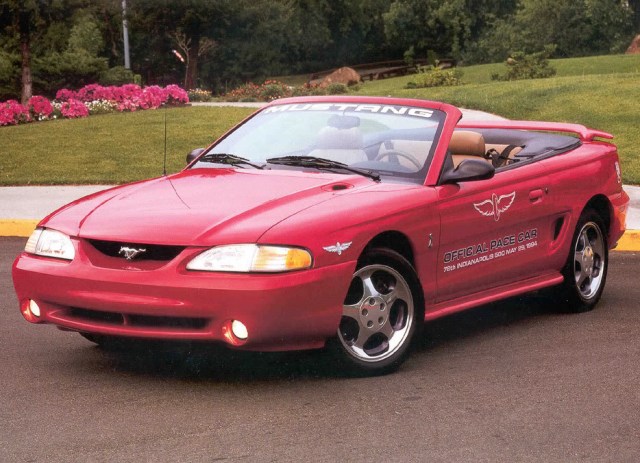
1994 Ford Mustang SVT Cobra Convertible Pace Car
The Cobra convertible was chosen to be the pace car for the 1994 Indy 500 race held in May 1994. To celebrate the honor all 1,000 1994.5 Cobra Convertibles produced were pace car replicas finished in Rio red with saddle tops and interiors. To complete the look “Official Pace Car” decals were supplied in the trunk of every car.
Changes to the Cobra for 1995 were nearly non-existent with the exception that the Cobra was now available with the full range of Mustang colours and the hardtop that was supposed to be optional on 1994 Mustang’s was finally ready for production and made available as an option for the Cobra. Unfortunately the hard top was a hard sell and after 499 of them were produced Ford quietly discontinued the option making a hard top convertible Mustang a rare find indeed.
1995 Mustang SVT Cobra R
For those who really lived life in the fast lane SVT once again offered a track spec Cobra R for weekend racers but this time Ford added some real muscle under the hood. Since the Cobra R was destined for use on the track SVT pulled out the 5.0-litre V-8 and installed a modified 5.8-litre Windsor V-8 that turned out 300-horsepower and 365-foot-pounds of torque. A 22-gallon Fuel Safe fuel cell replaced the gas tank of the regular production Cobra. Backing up the high strung V-8 was a Tremec TR-3550 5-speed manual transmission linked to a limited slip rear axle with a 3.27:1 ratio.
The suspension was beefed up with progressive rate Eibach coil springs, adjustable Koni struts and a large 30-millimeter anti-roll bar up front. Out back the Cobra R had liner rate Eibach coil springs, Koni shocks and a 27-millimeter anti-roll bar. Super wide 17x9-inch five spoke aluminum wheels wrapped with ultra sticky 255/45ZR17 BF Goodrich Comp T/A tires helped the car grip the tarmac. These modifications combined with the super stiff Fox-4 platform made the R a super handling factory produced track car.
Since the 1995 Cobra R was built to spend its life on the track all of the luxury items were stripped out of the car. Air-conditioning, cruise control, power-windows and door locks, radio, power-seats, rear defrost and leather wrapped steering wheel were all deleted. Even the rear seat was removed from the car to save weight. Because SVT assumed that most Cobra R buyers would install a set of racing seats the car came from the factory with the cloth seats from the base Mustang.
On the outside, SVT removed the fog lights and the radio antenna. The stock hood was replaced with special high-rise fiberglass cowl hood because the 5.8-litre engine was too tall to fit under the standard hood. All 250 SVT Cobra R’s came painted in white with a saddle interior and the only “R” emblems on the car were on the center caps of the five-spoke wheels.
Today the subdued 1995 SVT Cobra R has been pretty much forgotten by car collector and enthusiasts alike. But those who own and drive them would be hard pressed to forget the thrills that these cars provide.
1996-1998 Mustang
Nineteen ninety-six brought about major changes in side the engine compartment of the Mustang. After many years of service the legendary 5.0-litre V-8 was finally retired from the line-up and replaced with the ultra modern 4.6-litre modular V-8. The new V-8 had huge shoes to fill as the old five-point-oh could trace it’s roots right back to the 260-ci and 289-ci V-8’s offered in the original 1964.5-1966 Mustang and had a fanatical following of enthusiasts. There was also massive support from the aftermarket that offered enthusiasts just about every possible performance upgrade imaginable for the pushrod V-8. However time had moved on and the 5.0-litre was out dated and therefore could no longer meet ever tightening emissions regulations without costly modifications. While some lamented the end of the 5.0-litre and had their doubts that the new modular V-8 would be a suitable replacement, others anticipated the change with some excitement.
Because Ford knew that the engine change would be somewhat controversial and every aspect of the engine would be scrutinized by the press and Mustang fans alike, Ford was very careful to ensure that the 4.6-litre had the same 215-horsepower and 285-foot-pounds of torque ratings that the old 5.0-litre had. To some installing a new engine with the exact same power rating as the old one was a bit of a let down. But an improved power rating wasn’t the point for Ford. The fact that it was a thoroughly modern power-plant that would bring the Mustang well into the next millennium offering refinement, cleaner emissions and modern engineering was the initial goal of offering the new V-8.
The 4.6 was developed using a completely new design philosophy for automotive V-8 engines for Ford. These engines were not only a completely new design but were also manufactured using new processes and machinery that could allow the engine plant to easily change production from one version of the V-8 to another within a matter of hours. Because of this flexible manufacturing process Ford named this new engine series the Modular Engine. The modular engine was a radical departure from any V-8 Ford had produced in the past.
The 4.6-litre V-8 installed in the 1996 Mustang GT featured a chain driven single over-head camshaft operating two valves per-cylinder located in aluminum cylinder heads. The valves were actuated by hydraulic roller finger followers, eliminating the need for valve adjustments. Ford used very long bolts to clamp the cylinder head to the block. These special bolts reduced distortion of the cylinder bores therefore providing improved sealing.
The 90-degree cast iron engine block was deeply skirted with cross bolting for strength in order to lower engine noise and vibration and increase durability. A nodular cast iron crankshaft was used and bolted to it were a nifty set of connecting rods. These connecting rods were made of powdered metal and manufactured with the rod and cap as a one-piece unit. The large end of the rod is then cracked off thus separating the rod from the cap. This ensures that the rods and caps aren’t mismatched or installed backwards and are always an exact fit with one another. To keep everything lubricated and cool Ford used an integrated oil cooling system that used engine coolant to keep temperatures in check and potentially extend engine life.
A set of Teflon-coated hypereutectic pistons were press fit to the rods. Hypereutectic pistons, cast from high-silicon aluminum alloy are strong, light weight and offer a lower coefficient of thermal expansion; meaning they do not expand much with heat. This allowed engineers to run tighter tolerances for better oil control and consistent cylinder sealing. The modular 4.6-litre engine was not only a high tech modern engine that ran smooth; it was built to last and has proven to be an extremely reliable power plant with many examples lasting 500,000 plus kilometers without a rebuild.
The power steering pump, alternator, air-conditioning compressor and all idler and tension pulleys were mounted directly to the engine block. By doing this Ford eliminated all the brackets for the accessories making for a more compact engine assembly while also eliminating some unwanted engine noise and vibration at the same time. Ford also reduced maintenance costs for owners be installing long life platinum spark plugs, a 100,000 mile accessory drive belt, a distributor-less coil-on-plug electronic ignition system and the newly mandated OBD II diagnostic system.
Ford needed to do some reengineering in order to install the taller modular engine into the engine bay. The front crossmember and engine mounts were redesigned to allow the new V-8 to sit lower in the engine bay. The lower control arms were repositioned along with the steering rack and a new more compact brake booster was devised that used hydraulic pressure from the power steering pump instead of engine vacuum for brake assist. As a consequence of these changes the Mustang’s handling was improve with the car now feeling lighter and more responsive.
As silky and modern as the 4.6 might have been, many enthusiasts felt that the engine was a step backwards performance wise even though it produced the same horsepower and torque figures as the outgoing 5-litre. The problem was in the way the new engine produced its power. Overhead-valve engines like the 5-litre produce much of their torque, the twisting motion that accelerates the vehicle, at low engine speeds. These engines usually feel very powerful since they feel as if they are not working very hard to produce power. Overhead-cam engines such as the 4.6-litre are freer revving engines and produce power at higher engine revolutions. Therefore the feeling of instant thrust isn’t as pronounced since the engine has to ‘spool-up’ a little more to achieve its peak horsepower and torque. The refinement of the modular motor even further masked the sensory experience of speed; it was almost too smooth and quiet. This was perfect for a Lincoln Town Car or full sized Ford or Mercury for which the engine was originally installed in; but not so much for a performance car where most noises and vibrations are considered part of the driving experience.
Complicating matters even more was the fact that there was virtually no aftermarket support for the modular engine and aftermarket parts suppliers were a little slow at introducing high performance upgrades for the new engine. While most buyers could have cared less, hard core Mustang performance junkies were left out in the cold, twitching and anxious for their next fix. Eventually as time marched on the aftermarket industry embraced the new engine and enthusiasts began to appreciate the modular engine’s high-revving attributes and its potential to make colossal amounts of horsepower.
Buyers of V-6 powered Mustang’s were treated to an additional 10-horsepower for a total of 150 and the engine was now built up from the stiffer block of the supercharged 3.8-litre V-6 from the Thunderbird Super Coupe. The old Borg-Warner T-5 manual transmission was swapped for the new T-45 5-speed unit that had its bell housing and transmission case cast as a single unit resulting in a much more robust transmission assembly. Those who preferred two-pedal driving weren’t ignored either. The old 4-speed AOD automatic was retired and in its place was Ford’s more sophisticated 4R70W computer controlled transmission.
For added security GT’s received Ford’s Passive Anti-Theft System (PATS) to thwart off any criminals wanting to relieve the owners of Mustang GT’s of their prized possession. The system used a special key with a micro-chip embedded into it. This key would communicate with a special ignition switch to allow the vehicle to start. Without the coded key the ignition system would shut down and not allow the car to start thus making hot-wiring the car impossible.
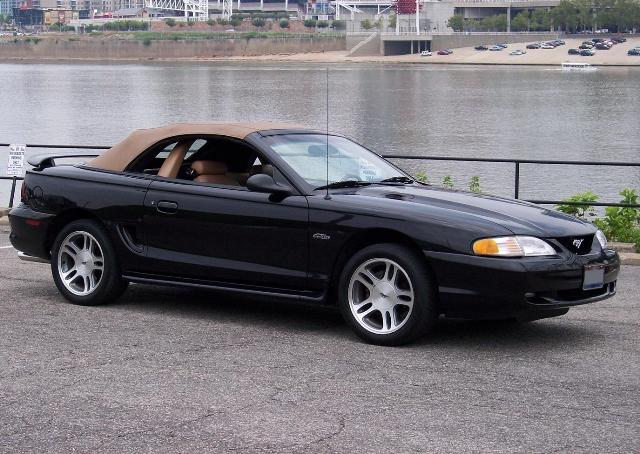
1997 Ford Mustang GT Convertible
The exterior of the Mustang received some subtle changes for 1996. A mesh grille was added behind the running pony emblem up front and vertical three bar tail lamps replaced the horizontal units paying homage to the original Mustang from 1964. GT models received new model identification badging on the front fenders. Aside from the new grill, taillights and fender badging on GT’s the Mustang received a few new colour choices; Moonlight Blue, Bright Tangerine, Deep Violet and Pacific Green. The GTS model was dropped however an option delete package was made available that echoed the equipment level of the defunct trim level.
Only a few changes were in store for 1997, the most exciting of them was a new set of optional diamond-cut 17-inch alloy wheels for GT models. All Mustangs now came standard with Ford’s Passive Anti-Theft System. Rounding out the news for 1997 were changes to interior colours and trim. Sales of the Mustang hit the skids in 1997 and fell by 20 percent over the equally dismal sales of 1996.
The Mustang soldiered on into 1998 with few changes once again; however one of these changes was very welcome. Power of the 4.6-litre modular V-8 increased to 225-horsepower and 290 pound-feet of torque thanks to some retuning wizardry and revised exhaust ports. Base Mustangs now came with air-conditioning, remote keyless entry, power trunk release, as well as power windows and door locks as standard equipment. The GT received an upgraded sound system and a rear spoiler was made standard. The dash mounted pod that housed the clock was eliminated and the clock was now located in the radio display.
1996-1998 Mustang SVT Cobra
While the single-overhead cam modular engine might have brought the Mustang GT screaming into the mid-nineties technologically, the new engine installed in the Cobra gave it an exotic flair. Instead of following past precedence of modifying the standard V-8 engine to produce more power, SVT took a giant leap and offered the Cobra with its own, unique, 4.6-litre twin-cam 32-valve V-8 engine. The double-overhead cam Cobra engine was a special piece; hand assembled by twelve two-person teams at Ford’s Romeo, Michigan plant.
Unlike the 4.6-litre modular engine installed in the Mustang GT that used an iron block, the Cobra’s engine block was made of cast aluminum and produced by Teksid of Italy. This deep-skirt aluminum block used iron cylinder liners and six bolts to secure each main bearing. Assembly teams installed a German-made fully counterweighted forged crankshaft into the lightweight block. A set of beefy powder-metal connecting rods were bolted to the crankshaft and the pistons were attached to the connecting rods via full-floating piston pins. At the bottom of the engine a windage tray was added to the oil pan to prevent the oil from sloshing about during aggressive driving maneuvers. A pair of aluminum cylinder heads housing four valves per combustion chamber and dual cams per head was bolted to the block. Valve timing was aggressive in order to sustain the torque curve high into the rpm range.
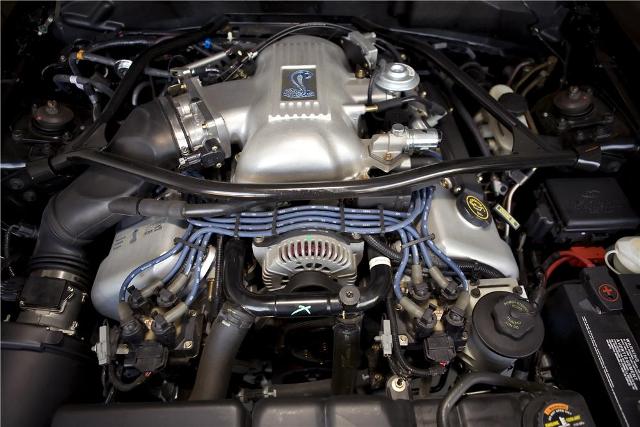
1996 Ford Mustang SVT Cobra Engine
The intake manifold could be considered not only a neat bit of engineering but also a work of art. Air enters into the manifold through dual 57-millimeter throttle plates and into “Siamesed” intake runner. Inside the aluminum intake manifold are eight tuned-length runners that lead down to primary and secondary intake ports. Below 3,500 rpm the secondary intake ports are blocked off by electronically controlled throttles. This causes the air-fuel mixture to swirl at lower engine speeds improving combustion. Above 3,500 rpm the secondary plates open thus unblocking the secondary intake runners allowing better breathing at higher engine speeds. It was an ingenious system that allowed the engine to take in copious amounts of air for the combustion process. Topping off the intake manifold was coiled snake emblem for all to see.
Once assembled the engine produced a stellar 305-horsepower, 300 pound feet of torque; more than enough thrust for the Cobra to keep pace with its competition from General Motors. The completed engines had a plate affixed to the valve cover with the signatures of the engine builders engraved onto it. This gave the Cobra the aura of an exotic, limited-production sports car.
Transmitting all that power to the limited-slip rear axle was the new Borg-Warner T-45 transmission.
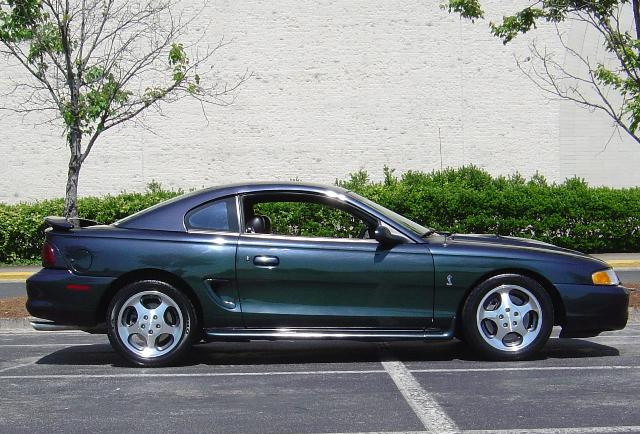
1996 Ford Mustang SVT Cobra Mystic
On the outside the Cobra was fitted with a new, larger, more aggressive power dome hood with larger air intake nostrils. This raised hood was required to clear the taller dual-cam 32-valve engine. At the rear the Cobra received the restyled vertical three-bar taillights and finally had its very own rear bumper with the letters “COBRA” proudly embossed into it. Most of the other exterior styling elements from the 1995 Cobra were carried over into 1996 model year but that didn’t stop SVT from making a very special looking Cobra for a lucky few.
For 1996 model year only SVT offered the Cobra with a unique “Mystic Paint” option. This psychedelic paint changed colour from green to purple to blue depending upon how the light reflected off the surface of the car. Production was limited to 2,000 vehicles out of the 10,000 Cobra’s built in 1996. This paint was like nothing else ever offered on a production car and today Mystic Cobra’s have a small but strong following among Mustang enthusiasts. Cobra’s carried over unchanged into 1997 with the exception of a new larger radiator. Five spoke wheels and an improved transmission were the only changes for the 1998 model year. Even with the limited changes Ford still sold every Cobra that they could produce year after year.
With the introduction of the 4.6-litre 32-valve engine the Mustang Cobra was no longer a great car in search of a great engine. The 305-horsepower “mod” motor provided ample power and refinement with a heavy dose of exotic technology and hand built exclusivity. Although the 4.6-litre Cobra sacrificed a little bit of low end grunt off the line, the new power train was vastly more flexible offering abundant power all the way up to its dizzying 6,800-rpm redline.
Because the modular engine required a reworked front suspension and engine cradle in order to wedge the new engine into the Cobra, SVT engineers took full advantage and reworked the front suspension and steering with amazing results making the 1996-1998 Cobra was one of the best handling Mustang’s ever. However many magazines anticipated that an independent rear suspension would be installed along with the new mod motor. Although a new trick rear suspension was never offered, Cobra buyers didn’t seem to mind too much.
The Cobra did receive the hydro-boost power braking system that was found on the Mustang GT. Combined with the massive 13-inch front disc brakes from the 1995 Cobra and standard equipment anti-lock brakes the Cobra could stop on a dime. On the track the Camaro could still out perform the Cobra, but just barely. However, the Cobra was much more comfortable and easier car to live with day in and day out and was therefore a more practical choice. The Cobra felt much more like a European touring coupe with the styling and power of an American car and buyers loved the cache of owning a limited production Mustang with a hand assembled exotic engine with a global pedigree.
Not everything was perfect however. Early 1996 Cobra’s suffered from overheating issues when driven hard on a hot day. This led Ford to issue a cooling upgrade kit for owners of current cars and changed to a larger radiator for 1997, a change that co-benefitted both the Cobra and Mustang GT. Surprisingly, the Borg-Warner T-45 transmission proved to be quite troublesome; with bent shift forks and rapid wear of synchronizers causing grinding gears. These faults were magically cured in 1998 when Tremec produced the T-45 under license. Finally, squealing drive belts were more of an annoyance but the fact they could fly off in spectacular fashion was more alarming; however both issues were corrected with changes during regular production..
Even with its minor faults the 1996-1998 SVT Cobra proved to be one of the best performance car bargains of the 1990’s giving owners V-8 powered muscle car thrills in a technologically refined package with a dose of exclusivity at a reasonable price. It’s no wonder Ford sold each and every Cobra it could make.
Top of the Charts
Although the 1994-1998 Mustang settled for second best on the track compared to the Camaro and Firebird, the Mustang had won the sales race with sales of two Mustangs for every Camaro/Firebird sold combined; decidedly beating down the G.M. twins. The Mustang’s practicality and flexibility made it a winner with the buying public, even with its performance deficit. Year after year Ford led in the Pony car sales race even when sales of the Mustang dipped. There was just something about the Mustang that appealed to people; perhaps it was because it was such a well rounded car.
Today the SN95 Mustang GT and Cobra have become a popular choice for the enthusiast crowd since these Mustang’s are currently cheap to purchase and easy to customize because of strong support from the aftermarket industry. Just like the Fox Body Mustang before it, one can purchase just about any go-fast part or appearance do-dad imaginable for the SN95. For many the car is an affordable entry into the fast and fun world of the pony car market.
With few styling changes since its introduction in 1994, and with the new millennium and the Mustang’s 35th anniversary fast approaching it was time that Ford make some changes to Mustang. Not only to freshen-up the car’s styling but also to address some of the complaints with the current model and they did so in a big way with the restyled Mustang for 1999.
Click here to continue reading on the next page about the 1999-2004 "New Edge" Mustang...
Most Popular Articles

Japanese Nostalgic Vehicles: The next trend in classic cars
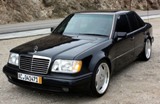
Five Sports Sedan's I'd Love to Own

Hot Hatchbacks From the 1980's

Volvo 200 Series: An Unappriciated Classic

Triumph TR-6: Music to Anyone's Ears
Fifty Years of Mustang
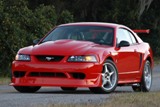
1999-2001 Ford Mustang SVT Cobra
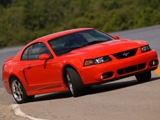
2003-2004 Ford Mustang SVT Cobra
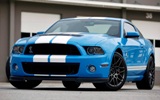
2010-2014 Ford Mustang Shelby GT500
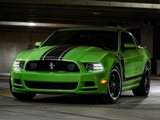
2012-2013 Ford Mustang Boss 302
Driven

Volvo 200 Series: An Unappriciated Classic

Triumph TR-6: Music to Anyone's Ears
1993 Nissan Skyline GT-s and GT-R Coupe

